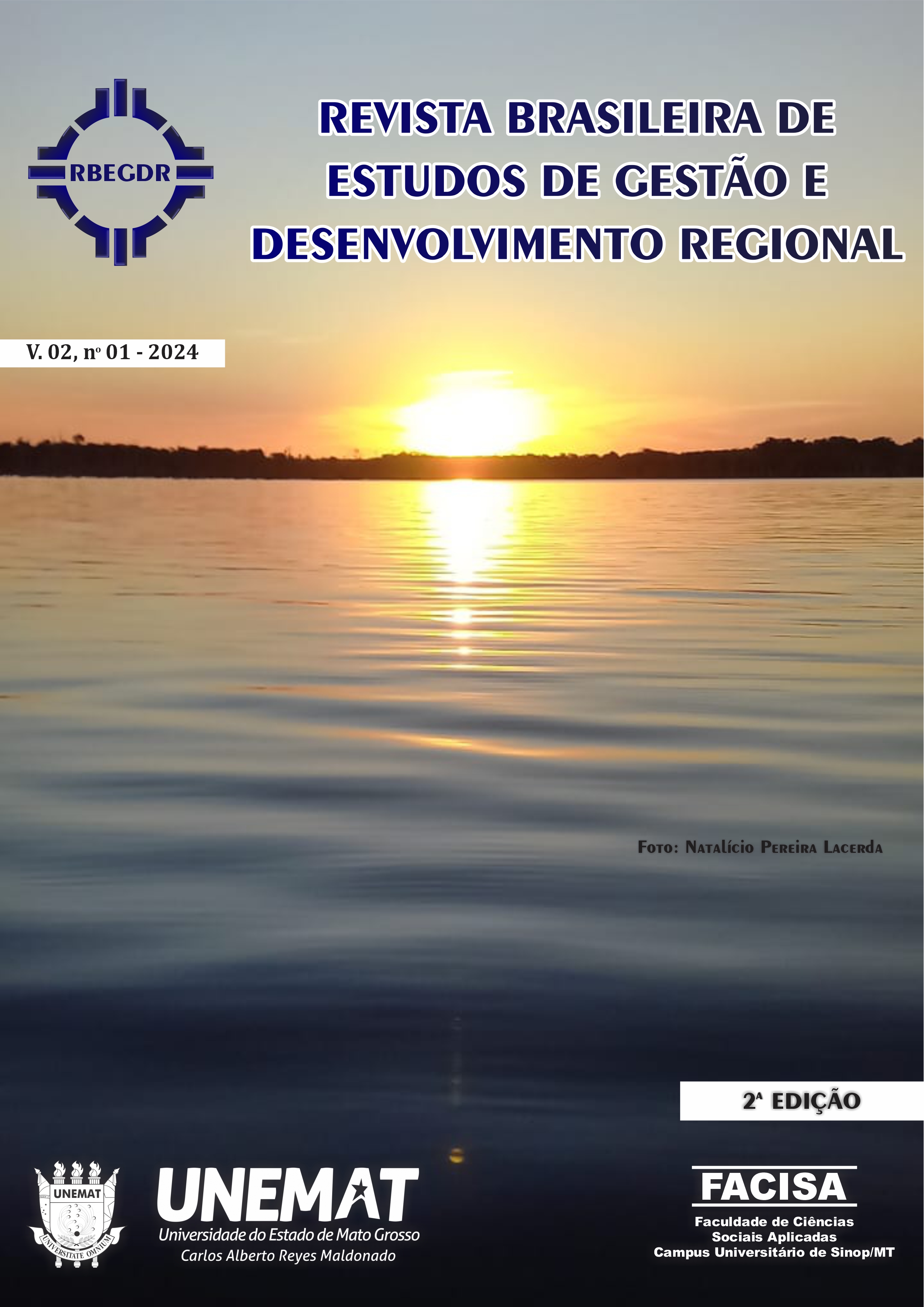CAPITAL SOCIAL: FORÇA MOBILIZADORA EM COMUNIDADES LOCAIS AMAZÔNICAS
DOI:
https://doi.org/10.30681/rbegdr.v2i1.12516Keywords:
Amazônia, Capital Social, Luhmann, RedesAbstract
As comunidades amazônicas em Unidades de Conservação, apresentam características únicas, como o desenvolvimento de atividades agroextrativistas, por isso, o presente ensaio teórico propõe um framework para análise multidimensional de desenvolvimento sustentável de comunidades amazônicas, em Reservas de Desenvolvimento Sustentável (RDS), baseado na força mobilizadora do capital social por meio da visão Luhmanniana de diferenciação sistema/ambiente, Adicionou-se uma proposta metodológica de Design Thinking (DT), que permitiu captar a diversidade de escolhas das atividades a serem desenvolvidas e a forma para organizar a sua discussão. Assim, ao analisar o funcionamento do sistema e como as relações sociais podem mobilizar vários grupos de interesse em vários níveis, possibilita o início de um processo de auto-organização para aprendizagem e geração de capital social.
Downloads
References
ANSARI, S.; MUNIR, K.; GREGG, T. Impact at the ‘Bottom of the Pyramid’: The Role of Social Capital in Capability Development and Community Empowerment. Journal of Management Studies, v. 49, n. 4, p. 2012. https://doi.org/10.1111/j.1467-6486.2012.01042.x
BABAEI, H.; AHMAD, N.; GILL, S. Bonding, Bridging and Linking Social Capital and Empowerment Among Squatter Settlements in Tehran, Iran. World Applied Sciences Journal, v. 17, n. 1, p. 119-126, 2012. https://www.idosi.org/wasj/wasj17(1)12/18.pdf
BRIDGER, J.; C., LULOFF, A. E. Building the Sustainable Community: Is Social Capital the Answer? Sociological Inquiry, v. 71, n. 4, p. 458-472, 2001. https://doi.org/10.1111/j.1475-682X.2001.tb01127.x
DALE, A.; NEWMAN, L. Sustainable Community Development, Networks and Resilience. Environments Journal, v. 34, n. 2, 2006. https://ssrn.com/abstract=2479757
DALE, A.; NEWMAN, L. Social capital: a necessary and sufficient condition for sustainable community development? Community Development Journal Advance Access, v. 45, n. 21, p. 5-21, 2008. https://doi.org/10.1093/cdj/bsn028
DAWE, N. K.; RYAN, K.L. The Faulty Three-Legged-Stool Model of Sustainable Development. Conservation Biology, v. 17, n. 5, p. 1458–1460, 2004. https://doi.org/10.1046/j.1523-1739.2003.02471.x
DODMAN, D.; MITLIN, D. Challenges for Community-Based Adaptation: Discovering the Potential for Transformation J. Int. Dev. v. 25, p. 640–659, 2013. https://doi.org/10.1002/jid.1772
DUEK, A.; BRODJONEGORO, B.; RUSLI, R. Reinterpreting Social Processes: How System Theory Can Help To Understand Organizations And The Example Of Indonesia’s Decentralization. E:CO Issue, v. 12, n. 4, p. 30-56, 2010.
EBI, K. L.; SEMENZA, J.C. Community-Based Adaptation to the Health Impacts of Climate Change. Am J Prev Med; v.35, n.5, 2008. https://doi.org/10.1016/j.amepre.2008.08.018
HAWKINS, R. L.; MAURER, K. Bonding, Bridging and Linking: How Social Capital Operated in New Orleans following Hurricane Katrina. British Journal of Social Work, v. 40, 1777–1793, 2010. https://doi.org/10.1093/bjsw/bcp087
LEHTONEN, M..The environmental–social interface of sustainable development: capabilities, social capital, institutions. Ecological Economics, v. 49, p. 199– 214, 2004. https://doi.org/10.1016/j.ecolecon.2004.03.019
LEONARD, M. Bonding and Bridging Social Capital:Reflections from Belfast. Sociology-Sage Publications, v. 38, n. 5, p. 927–944, 2004 https://doi.org/10.1177/0038038504047176
LUHMANN, N. Differentiation of Society.Canadian Journal of Sociology / Cahiers Canadiens de Sociologie, v. 2, n. 1, p. 29-53, 1977. https://doi.org/10.2307/3340510
MARCONATTO, D. A.; PEDROZO, E. A. Capital social: visão integrada. Revista Brasileira de Gestão e Desenvolvimento Regional.Taubaté, n. 2, p. 154 - 181, mai/agost 2013. https://www.rbgdr.net/revista/index.php/rbgdr/article/view/1025
NEWMAN, L.; DALE, A.The Role of Agency in Sustainable Local Community Development. Local Environment, v. 10, n. 5, p. 477–486, 2005. https://doi.org/10.1080=13549830500203121
NEWMAN, L.; DALE, A. Homophily And Agency: Creating Effective Sustainable Development Networks. Development and Sustainability, v. 9, p. 79–90, 2007. https://doi.org/10.1007/s10668-005-9004-5
ONYX, J.; LEONARD, R..The Conversion of Social Capital into Community Development: na Intervention in Australia’s Outback. International Journal of Urban and Regional Research, v. 34, n. 2, p. 381–97, 2010. https://doi.org/10.1111/j.1468-2427.2009.00897
PATULNY, R. V. Exploring the social capital grid: bonding, bridging, qualitative, quantitative. International Journal of Sociology and Social Policy, v. 27 n. ½, pp. 32-51, 2007. https://doi.org/10.1108/01443330710722742
PELLING, M.; HIGH, C. Understanding adaptation: What can social capital offer assessments of adaptive capacity? Global Environmental Change, v. 15, p. 308–319, 2005. https://doi.org/10.1016/j.gloenvcha.2005.02.001
SZRETER, S.; WOOLCOCK, M. Health by association? Social capital, social theory, and the political economy of public health. International Journal of Epidemiology, v. 33, p. 650–667, 2004. https://doi.org/doi:10.1093/ije/dyh013
TURNER, J. H. The formation of social capital. In DASGUPTA, P., SERAGELDIN, I. (eds.). Social Capital: A Multifaceted Perspective. Washington: World Bank. pp.94-146, 2000.
VIANNA, M. et al. Design thinking: inovação em negócios. - Rio de Janeiro: MJV Press, 2012. 162p.
Downloads
Published
Issue
Section
License
Copyright (c) 2024 Revista Brasileira de Estudos de Gestão e Desenvolvimento Regional

This work is licensed under a Creative Commons Attribution-NonCommercial 4.0 International License.
Esta revista oferece acesso livre imediato ao seu conteúdo, seguindo o princípio de que disponibilizar de forma gratuita, a produção da comunidade científica ao público, proporciona maior democratização do conhecimento. A política é Acesso Aberto.
Adotamos a licença CC Attribution-NonCommercial 4.0, a qual permite o compartilhamento, uso, citação, adaptação, desde que citada fonte e não alterada a licença inicial. O uso da publicação para fins comerciais não é permitido. Dessa maneira não são cobradas nenhum tipo de taxa na revista.





